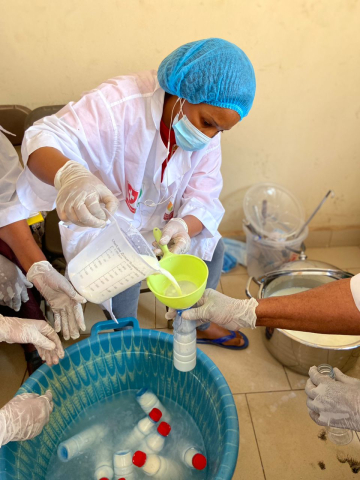The Gagnoa-Lakota Training Centre is a public structure belonging to the National Agency for Rural Development Support (ANADER). Its main mission is to train ANADER staff, as well as supervisory technicians, farmers, NGO technical teams, informal groups, cooperators and breeders.
The training modules offered by the center focus on the sustainability of different crops (coffee, cocoa, etc.). These training courses contribute to the fight against poverty, job creation, the reduction of food insecurity, the marketing of agricultural products locally, and the provision of quality supervisory staff for producers.
The Gagnoa-Lakota Training Centre, which provides training in sustainable cocoa and coffee farming, has already invested in a number of agroecological practices, such as the Agroforestry System (SAF).
The project's support is a major asset for continued production of the coffee-cocoa pairing in the years to come. The project will also strengthen and enhance the center's training capabilities in a highly complex climatic context, coupled with the scarcity of quality land.
This project will strengthen the center's training capacities and skills, with the introduction of new teaching units at the center, such as beekeeping, improved traditional poultry farming and small ruminant (sheep) rearing.
These new activities will reinforce the existing teaching units, which are committed to the agroecological approach. The project will help the center to operate as a system through its various production units. For example, bees to pollinate flowers, and the integration of improved traditional poultry farming and small ruminant (sheep) rearing to enhance the agroecological performance of the project beneficiaries' agricultural production sites.
All this will help optimize production while creating added value. The management of these production sites will encourage biological control within the production ecosystem, thus limiting the use of chemical pesticides, which will contribute to the preservation of the environment and biodiversity. All this will be made possible by strengthening the technical and pedagogical capacities of the center's trainers and managers.
General objective: To contribute to improving the Agroecology training courses.
Specific objectives
The implementation strategy is based on developing the technical and pedagogical skills of the center's trainers and managers in agroecology, pedagogical engineering and training. It will also involve increasing the center's training infrastructure potential (accommodation, training rooms, demonstration and application units) and diversifying agricultural activities (integrating livestock farming in association with the existing agroforestry orchard). All this will enhance the center's agroecology training courses and enable it to reach a greater number of trained producers.
Outcome 1
- Capacity-building for the center's human resources: 16 agents (trainers and managers)
Outcome 2
- The development of at least 3 training modules in agroecology according to APC;
Outcome 3
- Development of an agroecology training manual ;
Outcome 4
- Development of 03 sites to set up agroecology teaching units.
Outcome 5
- Training of 150 beneficiaries, including 60 young producers, 50 women producers and 40 adult producers
Outcome 6
- Installation of a 40-hive beekeeping unit with equipment
Outcome 7
- Construction of an improved traditional henhouse for 44 birds, complete with equipment
Outcome 8
- Construction of a sheepfold for a pseudo-nucleus of 11 head with equipment
Outcome 9
- Rehabilitation of a 10-room dormitory block with shower rooms
Outcome 10
- Rehabilitation of 2 training rooms with teaching equipment
Outcome 11
- Borehole installation
Outcome 12
- Acquisition of small agroecological production tools: wheelbarrows, shovels, picks, etc.





